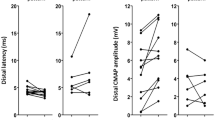Abstract
Many Guillain-Barré syndrome (GBS) and Chronic Inflammatory Demyelinating Polyneuropathy (CIDP) patients recover well, but suffer from excessive fatigue, which may persist for years and reduce the quality of life considerably. In order to determine whether residual subclinical peripheral nerve dysfunction is a possible underlying mechanism of fatigue, we performed standardized nerve conduction (NC) studies in 16 fatigued patients, mean 6.5 years after diagnosis. Thirteen were relatively well recovered from GBS and 3 had stable CIDP. In contrast to CIDP, most NC values in GBS patients were remarkably restored and within normal values.No correlations were found between the electrophysiological findings and the fatigue scores,muscle strength, or functional scores. This study demonstrates that fatigue in GBS is not explained by residual nerve dysfunction, using conventional NC measurements.
Similar content being viewed by others
References
Alam TA, Chaudhry V, Cornblath DR (1998) Electrophysiological studies in the Guillain-Barré syndrome: distinguishing subtypes by published criteria. Muscle Nerve 21:1275–1279
Atanasova D, Ishpekova B, Muradyan N, Novachkova S, Daskalov M (2004) Conduction block – the diagnostic value in the early stage of Guillain- Barré syndrome. Electromyogr Clin Neurophysiol 44:361–364
Brown WF, Feasby TE (1984) Conduction block and denervation in Guillain- Barré polyneuropathy. Brain 107:219–239
Buschbacher RM (2000) Manual of NC Studies, Demos Medical Publishing, Inc. New York
De la Cour CD, Andersen H, Stalberg E, Fuglsang-Frederiksen A, Jakobsen J (2005) Electrophysiological signs of permanent axonal loss in a follow-up study of patients with Guillain-Barré syndrome. Muscle Nerve 31:70–77
Emery AE (1997) Criteria for Neuromuscular Disorders, Royal Society of Medicine Press Limited, London
EuroQol Group (1990) A new facility for the measurement of health-related quality of life. Health Policy 16: 199–208
Garssen MP, Bussmann JB, Schmitz PI, Zandbergen A, Welter TG, Merkies IS, Stam HJ, van Doorn PA (2004) Physical training and fatigue, fitness, and quality of life in Guillain-Barré syndrome and CIDP. Neurology 63:2393–2395
Hahn AF (1998) Guillain-Barré syndrome. Lancet 352:635–641
Hausmanowa-Petrusewicz I, Emeryk B, Rowinska-Marcinska K, Jedrzejowska H (1979) Nerve conduction in the Guillain-Barré-Strohl syndrome. J Neurol 220:169–184
Jablecki CK, Andary MT, So YT, Wilkins DE, Williams FH (1993) Literature review of the usefulness of nerve conduction studies and electromyography for the evaluation of patients with carpal tunnel syndrome. AAEM Quality Assurance Committee. Muscle Nerve 16:1392–1414
Kleyweg RP, van der Meché FG, Schmitz PI (1991) Interobserver agreement in the assessment of muscle strength and functional abilities in Guillain-Barré syndrome. Muscle Nerve 14:1103–1109
Krupp LB, LaRocca NG, Muir-Nash J, Steinberg AD (1989) The fatigue severity scale. Application to patients with multiple sclerosis and systemic lupus erythematosus. Arch Neurol 46:1121–1123
Kuwabara S, Ogawara K, Mizobuchi K, Mori M, Hattori T (2001) Mechanisms of early and late recovery in acute motor axonal neuropathy. Muscle Nerve 24:288–291
Martinez-Figueroa A, Hansen S, Ballantyne JP (1977) A quantitative electrophysiological study of acute idiopathic polyneuritis. J Neurol Neurosurg Psychiatry 40:156–161
McLeod JG, Walsh JC, Prineas JW, Pollard JD (1976) Acute idiopathic polyneuritis. A clinical and electrophysiological follow-up study. J Neurol Sci 27:145–162
Merkies IS, Schmitz PI, Samijn JP, van der Meché FG, van Doorn PA (1999) Fatigue in immune-mediated polyneuropathies. European Inflammatory Neuropathy Cause and Treatment (INCAT) Group. Neurology 53:1648–1654
Merkies IS, Schmitz PI, van der Meché FG, van Doorn PA (2003) Comparison between impairment and disability scales in immune-mediated polyneuropathies. Muscle Nerve 28:93–100
Pleasure DE, Lovelace RE, Duvoisin RC (1968) The prognosis of acute polyradiculoneuritis. Neurology 18:1143–1148
Ruijten MW, Salle HJ, Kingma R (1993) Comparison of two techniques to measure the motor nerve conduction velocity distribution. Electroencephalogr Clin Neurophysiol 89:375–381
Schillings ML, Hoefsloot W, Stegeman DF, Zwarts MJ (2003) Relative contributions of central and peripheral factors to fatigue during a maximal sustained effort. Eur J Appl Physiol 90:562–568
Van der Meché FG, Meulstee J, Vermeulen M, Kievit A (1988) Patterns of conduction failure in the Guillain- Barré syndrome. Brain 111:405–416
Van der Meché FG, van Doorn PA, Meulstee J, Jennekens FG (2001) Diagnostic and classification criteria for the Guillain-Barré syndrome. Eur Neurol 45:133–139
Author information
Authors and Affiliations
Corresponding author
Rights and permissions
About this article
Cite this article
Garssen, M.P.J., van Doorn, P.A. & Visser, G.H. Nerve conduction studies in relation to residual fatigue in Guillain-Barré syndrome. J Neurol 253, 851–856 (2006). https://doi.org/10.1007/s00415-006-0962-9
Received:
Revised:
Accepted:
Published:
Issue Date:
DOI: https://doi.org/10.1007/s00415-006-0962-9




